Delta 22-590 User Manual
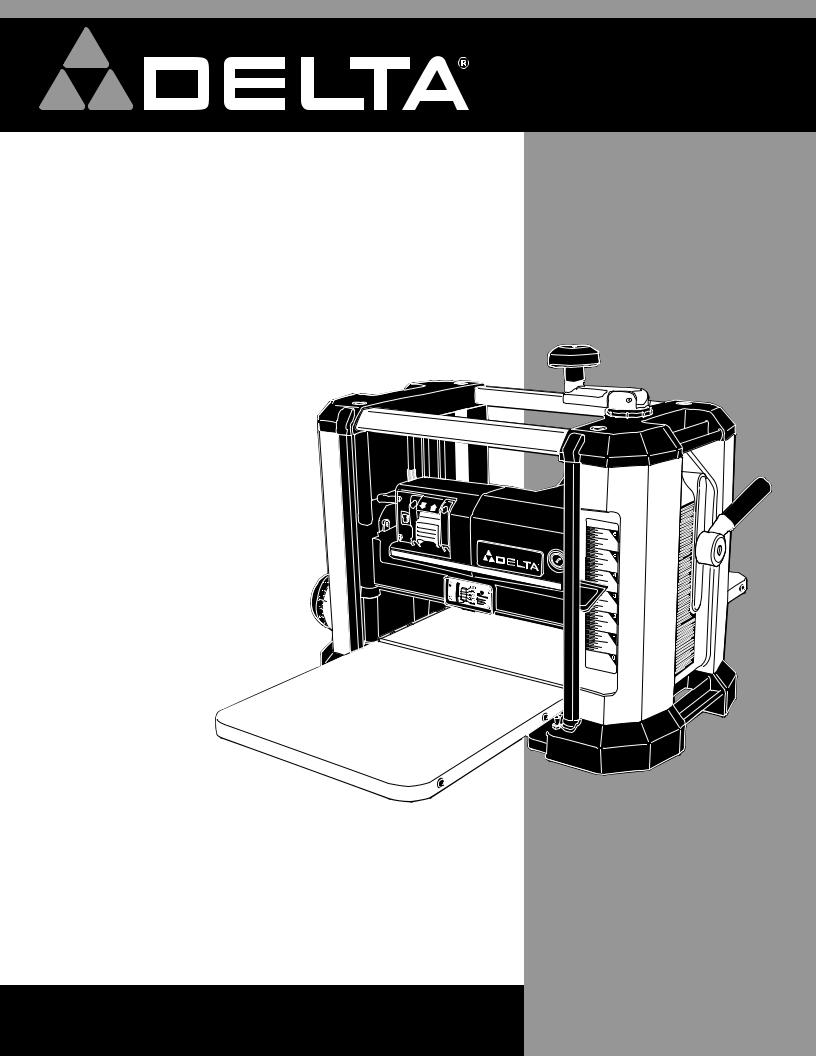
13" PORTABLE PLANER
Raboteuse de 330 mm (13 po)
Cepilladora de 330 mm (13")
Français (17)
Español (33)
Instruction manual
Manuel d’utilisation
Manual de instrucciones
www.deltaportercable.com
INSTRUCTIVO DE OPERACIÓN, CENTROS
DE SERVICIO Y PÓLIZA DE GARANTÍA.
 LÉASE ESTE INSTRUCTIVO
LÉASE ESTE INSTRUCTIVO
ANTES DE USAR EL PRODUCTO.
22-590
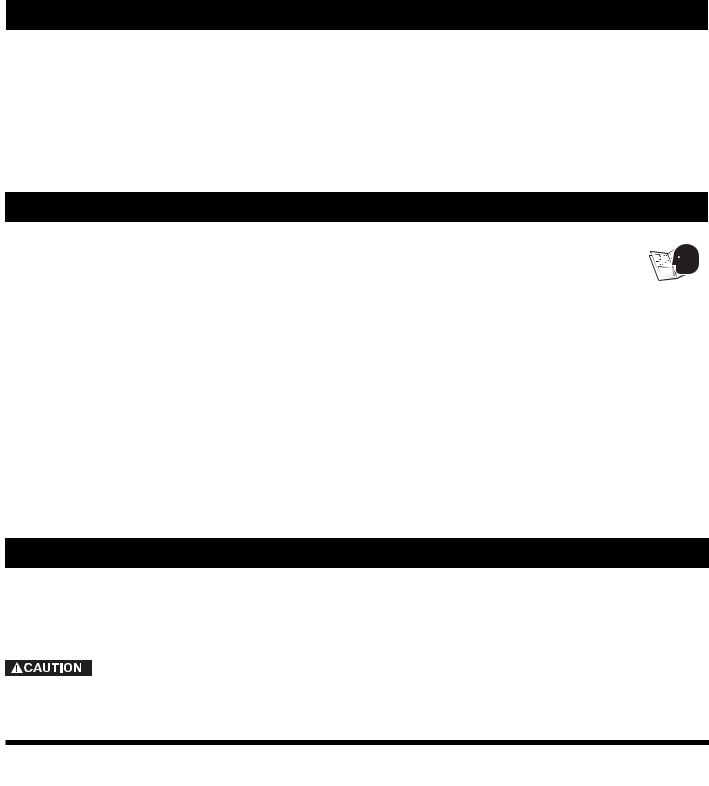
TABLE OF CONTENTS
IMPORTANT SAFETY INSTRUCTIONS .................... |
2 |
TROUBLESHOOTING ................................................ |
12 |
SAFETY GUIDELINES - DEFINITIONS ..................... |
2 |
MAINTENANCE.......................................................... |
12 |
GENERAL SAFETY RULES ....................................... |
3 |
SERVICE..................................................................... |
14 |
ADDITIONAL SPECIFIC SAFETY RULES ................ |
4 |
ACCESSORIES........................................................... |
16 |
FUNCTIONAL DESCRIPTION ................................... |
6 |
WARRANTY................................................................ |
16 |
CARTON CONTENTS ............................................... |
6 |
FRANÇAIS .................................................................. |
17 |
ASSEMBLY ................................................................. |
7 |
ESPAÑOL.................................................................... |
33 |
OPERATION ............................................................... |
9 |
|
|
IMPORTANT SAFETY INSTRUCTIONS
 Read all warnings and operating instructions before using any tool or equipment. When using tools or equipment, basic safety precautions should always be followed to reduce the risk of personal injury. Improper operation, maintenance or modification of tools or equipment could result in serious injury and property damage. There are certain applications for which tools and equipment
Read all warnings and operating instructions before using any tool or equipment. When using tools or equipment, basic safety precautions should always be followed to reduce the risk of personal injury. Improper operation, maintenance or modification of tools or equipment could result in serious injury and property damage. There are certain applications for which tools and equipment
are designed. DELTA Machinery strongly recommends that this product NOT be modified and/or used for any application other than for which it was designed.
If you have any questions relative to its application DO NOT use the product until you have written DELTA Machinery and we have advised you. Contact us online at www.deltaportercable.com or by mail at End User Services, DELTA Machinery, 4825 Highway 45 North, Jackson, TN 38305. In Canada,125 Mural St. Suite 300, Richmond Hill, ON, L4B 1M4.
Information regarding the safe and proper operation of this tool is available from the following sources:
•Power Tool Institute, 1300 Sumner Avenue, Cleveland, OH 44115-2851or online at www.powertoolinstitute.com
•National Safety Council, 1121 Spring Lake Drive, Itasca, IL 60143-3201
•American National Standards Institute, 25 West 43rd Street, 4 floor, New York, NY 10036 www.ansi.org - ANSI 01.1 Safety Requirements for Woodworking Machines
•U.S. Department of Labor regulations www.osha.gov
SAVE THESE INSTRUCTIONS!
SAFETY GUIDELINES - DEFINITIONS
It is important for you to read and understand this manual. The information it contains relates to protecting YOUR SAFETY and PREVENTING PROBLEMS. The symbols below are used to help you recognize this information.

 indicates an imminently hazardous situation which, if not avoided, will result in death or serious injury.
indicates an imminently hazardous situation which, if not avoided, will result in death or serious injury.  indicates a potentially hazardous situation which, if not avoided, could result in death or serious injury.
indicates a potentially hazardous situation which, if not avoided, could result in death or serious injury.
indicates a potentially hazardous situation which, if not avoided, may result in minor or moderate injury.
NOTICE |
indicates a practice not related to personal injury which, if not avoided, may result in property |
damage.
 Some dust created by power sanding, sawing, grinding, drilling, and other construction activities contains chemicals known to the State of California to cause cancer, birth defects or other reproductive harm. Some examples of these chemicals are:
Some dust created by power sanding, sawing, grinding, drilling, and other construction activities contains chemicals known to the State of California to cause cancer, birth defects or other reproductive harm. Some examples of these chemicals are:
•Lead from lead-based paints,
•Crystalline silica from bricks and cement and other masonry products, and
•Arsenic and chromium from chemically-treated lumber (CCA).
Your risk from these exposures varies, depending on how often you do this type of work. To reduce your exposure to these chemicals: work in a well-ventilated area, and work with approved safety equipment, such as those dust masks that are specially designed to filter out microscopic particles.
2

GENERAL SAFETY RULES
 Failure to follow these rules may result in serious personal injury.
Failure to follow these rules may result in serious personal injury.
1.For your own safety, read the instruction manual before operating the machine. Learning the machine’s application, limitations, and specific hazards will greatly minimize the possibility of accidents and injury.
2.Wear eye and hearing protection and always use safety glasses. Everyday eyeglasses are not safety glasses. Use certified safety equipment. Eye protection equipment should comply with ANSI Z87.1 standards. Hearing equipment should comply with ANSI S3.19 standards.
3.Wear proper apparel. Do not wear loose clothing, gloves, neckties, rings, bracelets, or other jewelry which may get caught in moving parts. Nonslip protective footwear is recommended. Wear protective hair covering to contain long hair.
4.Do not use the machine in a dangerous environment.
The use of power tools in damp or wet locations or in rain can cause shock or electrocution. Keep your work area well-lit to prevent tripping or placing arms, hands, and fingers in danger.
5.Do not operate electric tools near flammable liquids or in gaseous or explosive atmospheres. Motors and switches in these tools may spark and ignite fumes.
6.Maintain all tools and machines in peak condition.
Keep tools sharp and clean for best and safest performance. Follow instructions for lubricating and changing accessories. Poorly maintained tools and machines can further damage the tool or machine and/or cause injury.
7.Check for damaged parts. Before using the machine, check for any damaged parts. Check for alignment of moving parts, binding of moving parts, breakage of parts, and any other conditions that may affect its operation. A guard or any other part that is damaged should be properly repaired or replaced with DELTA or factory authorized replacement parts. Damaged parts can cause further damage to the machine and/or injury.
8.Keep the work area clean. Cluttered areas and benches invite accidents.
9.Keep children and visitors away. Your shop is a potentially dangerous environment. Children and visitors can be injured.
10.Reduce the risk of unintentional starting. Make sure that the switch is in the “OFF” position before plugging in the power cord. In the event of a power failure, move the switch to the “OFF” position. An accidental start-up can cause injury. Do not touch the plug’s metal prongs when unplugging or plugging in the cord.
11.Use the guards. Check to see that all safety devices are in place, secured, and working correctly to prevent injury.
12.Remove adjusting keys and wrenches before starting the machine. Tools, scrap pieces, and other debris can be thrown at high speed, causing injury.
13.Use the right machine. Don’t force a machine or an attachment to do a job for which it was not designed. Damage to the machine and/or injury may result.
14.Use recommended accessories. The use of accessories and attachments not recommended by DELTA may cause damage to the machine or injury to the user.
15.Use the proper extension cord. Make sure your extension cord is in good condition. When using an extension cord, be sure to use one heavy enough to carry the current your product will draw. An undersized cord will cause a drop in line voltage, resulting in loss of power and overheating. See the Extension Cord Chart for the correct size depending on the cord length and nameplate ampere rating. If in doubt, use the next heavier gauge. The smaller the gauge number, the heavier the cord.
16.Secure the workpiece. Use clamps or a vise to hold the workpiece when practical. Loss of control of a workpiece can cause injury.
17.Feed the workpiece against the direction of the rotation of the blade, cutter, or abrasive surface.
Feeding it from the other direction will cause the workpiece to be thrown out at high speed.
18.Don’t force the workpiece on the machine. Damage to the machine and/or injury may result.
19.Don’t overreach. Loss of balance can make you fall into a working machine, causing injury.
20.Never stand on the machine. Injury could occur if the tool tips, or if you accidentally contact the cutting tool.
21.Never leave the machine running unattended. Turn the power off. Don’t leave the machine until it comes to a complete stop. A child or visitor could be injured.
22.Turn the machine “OFF”, and disconnect the machine from the power source before installing or removing accessories, changing cutters, adjusting or changing set-ups. When making repairs, be sure to lock the start switch in the “OFF” position. An accidental start-up can cause injury.
23.Make your workshop childproof with padlocks, master switches, or by removing starter keys. The accidental start-up of a machine by a child or visitor could cause injury.
24.Stay alert, watch what you are doing, and use common sense. Do not use the machine when you are tired or under the influence of drugs, alcohol, or medication. A moment of inattention while operating power tools may result in injury.
25. Use of this tool can generate and disperse dust or other airborne particles, including wood dust, crystalline silica dust and asbestos dust.
Use of this tool can generate and disperse dust or other airborne particles, including wood dust, crystalline silica dust and asbestos dust.
Direct particles away from face and body. Always operate tool in well ventilated area and provide for proper dust removal. Use dust collection system wherever possible. Exposure to the dust may cause serious and permanent respiratory or other injury, including silicosis (a serious lung disease), cancer, and death. Avoid breathing the dust, and avoid prolonged contact with dust. Allowing dust to get into your mouth or eyes, or lay on your skin may promote absorption of harmful material. Always use properly fitting NIOSH/OSHA approved respiratory protection appropriate for the dust exposure, and wash exposed areas with soap and water.

ADDITIONAL SPECIFIC SAFETY RULES
FAILURE TO FOLLOW THESE RULES MAY RESULT IN SERIOUS PERSONAL INJURY.
1.DO NOT OPERATE THIS MACHINE until it is completely assembled and installed according to the instructions. A machine incorrectly assembled can cause serious injury.
2.OBTAIN ADVICE from your supervisor, instructor, or another qualified person if you are not thoroughly familiar with the operation of this machine. Knowledge is safety.
3.FOLLOW ALL WIRING CODES and recommended electrical connections to prevent shock or electrocution.
4.KEEP KNIVES SHARP and free from rust and pitch. Dull or rusted knives work harder and can cause kickback.
5.NEVER TURN THE MACHINE “ON” before clearing the table of all objects (tools, scraps of wood, etc.). Flying debris can cause serious injury.
6. NEVER TURN THE MACHINE “ON” with the workpiece contacting the cutterhead. Kickback can occur.
7.SECURE THE MACHINE TO A SUPPORTING SURFACE to prevent the machine from sliding, walking or tipping over.
8.PROPERLY SECURE THE KNIVES IN THE CUTTERHEAD before turning the power “ON”. Loose blades may be thrown out at high speeds causing serious injury.
9.DO NOT PLACE THE POWER CORD under the cutterhead when moving or storing.
10.AVOID AWKWARD OPERATIONS AND HAND POSITIONS. A sudden slip could cause a hand to move into the knives.
11.KEEP ARMS, HANDS, AND FINGERS away from the cutterhead, the chip exhaust opening, and the feed rollers to prevent severe cuts.
12.NEVER REACH INTO THE CUTTERHEAD AREA while the machine is running. Your hands can be drawn into the knives.
13.DO NOT STAND IN LINE OF THE WORKPIECE.
Kickback can cause injury.
14.ALLOW THE CUTTERHEAD TO REACH FULL SPEED before feeding a workpiece.
15.WHEN PLANING BOWED STOCK, place the concave (cup down) side of the stock on the table and cut with the grain to prevent kickback.
16.DONOTFEEDAWORKPIECEthatiswarped, contains knots, or is embedded with foreign objects (nails, staples, etc.). Kickback can occur.
17.DO NOT FEED A SHORT, THIN, OR NARROW WORKPIECE INTO THE MACHINE. Your hands can be drawn into the knives and/or the workpiece can be thrown at high speeds. See the “OPERATION” section of this instruction manual for details.
18.DO NOT FEED A WORKPIECE into the outfeed end of the machine. The workpiece will be thrown out of the opposite side at high speeds.
19.REMOVE SHAVINGS ONLY with the power “OFF” to prevent serious injury.
20.USE FOR WOOD ONLY. Do not plane man-made materials.
21.PROPERLY SUPPORT LONG OR WIDE WORKPIECES. Loss of control of the workpiece can cause serious injury.
22.NEVER PERFORM LAYOUT, ASSEMBLY or set-up work on the table/work area when the machine is running. Serious injury will result.
23.TURN THE MACHINE “OFF”, DISCONNECT IT FROM THE POWER SOURCE, and clean the table/ work area before leaving the machine. LOCK THE SWITCH IN THE “OFF” POSITION to prevent unauthorized use. Someone else might accidentally start the machine and cause injury to themselves or others.
24.ADDITIONAL INFORMATION regarding the safe and proper operation of power tools (i.e. a safety video) is available from the Power Tool Institute, 1300 Sumner Avenue, Cleveland, OH 441152851 (www.powertoolinstitute.com). Information is also available from the National Safety Council, 1121 Spring Lake Drive, Itasca, IL 60143-3201. Please refer to the American National Standards Institute ANSI 01.1 Safety Requirements for Woodworking Machines and the U.S. Department of Labor Regulations.
SAVE THESE INSTRUCTIONS. Refer to them often and use them to instruct others.
POWER CONNECTIONS
A separate electrical circuit should be used for your machines. This circuit should not be less than #12 wire and should be protected with a time delay fuse. NOTE: Time delay fuses should be marked “D” in Canada and “T” in the US. If an extension cord is used, use only 3-wire extension cords which have 3-prong grounding type plugs and matching receptacle which will accept the machine’s plug. Before connecting the machine to the power line, make sure the switch is in the “OFF” position and be sure that the electric current is of the same characteristics as indicated on the machine. All line connections should make good contact. Running on low voltage will damage the machine.
Do not expose the machine to rain or operate the machine in damp locations.
MOTOR SPECIFICATIONS
Your machine is wired for 120 volt, 60 Hz alternating current. Before connecting the machine to the power source, make sure the switch is in the “OFF” position.
GROUNDING INSTRUCTIONS
 This machine must be grounded while in use to protect the operator from electric shock.
This machine must be grounded while in use to protect the operator from electric shock.
4

1.All grounded, cord-connected machines:
In the event of a malfunction or breakdown, grounding provides a path of least resistance for electric current to reduce the risk of electric shock. This machine is equipped with an electric cord having an equipment-grounding conductor and a grounding plug. The plug must be plugged into a matching outlet that is properly installed and grounded in accordance with all local codes and ordinances.
Do not modify the plug provided - if it will not fit the outlet, have the proper outlet installed by a qualified electrician. Improper connection of the equipment-grounding conductor can result in risk of electric shock. The conductor with insulation having an outer surface that is green with or without yellow stripes is the equipment-grounding conductor. If repair or replacement of the electric cord or plug is necessary, do not connect the equipment-grounding conductor to a live terminal.
Check with a qualified electrician or service personnel if the grounding instructions are not completely understood, or if in doubt as to whether the machine is properly grounded.
Use only 3-wire extension cords that have 3-prong grounding type plugs and matching 3-conductor receptacles that accept the machine’s plug, as shown in Fig. A.
Repair or replace damaged or worn cord immediately.
2.Grounded, cord-connected machines intended for use on a supply circuit having a nominal rating less than 150 volts:
If the machine is intended for use on a circuit that has an outlet that looks like the one illustrated in Fig. A, the machine will have a grounding plug that looks like the plug illustrated in Fig. A. A temporary adapter, which looks like the adapter illustrated in Fig. B may be used to connect this plug to a matching 2-conductor receptacle as shown in Fig. B, if a properly grounded outlet is not available. The temporary adapter should be used only until a properly grounded outlet can be installed by a qualified electrician. The green-colored rigid ear, lug, and the like, extending from the adapter must be connected to a permanent ground such as a properly grounded outlet box. Whenever the adapter is used, it must be held in place with a metal screw.
NOTE: In Canada, the use of a temporary adapter is not permitted by the Canadian Electric Code.
 In all cases, make certain that the receptacle in question is properly grounded. If you are not sure, have a qualified electrician check the receptacle.
In all cases, make certain that the receptacle in question is properly grounded. If you are not sure, have a qualified electrician check the receptacle.
GROUNDED OUTLET BOX
CURRENT
CARRYING
PRONGS
GROUNDING BLADE
IS LONGEST OF THE 3 BLADES
Fig. A
EXTENSION CORDS


 Use proper extension cords. Make sure your extension cord is in good condition and is a 3-wire extension cord which has a 3-prong grounding type plug and matching receptacle which will accept the machine’s plug. When using an extension cord, be sure to use one heavy enough to carry the current of the machine. An undersized cord will cause a drop in line voltage, resulting in loss of power and overheating. Fig. C shows the correct gauge to use depending on the cord length. If in doubt, use the next heavier gauge. The smaller the gauge number, the heavier the cord.
Use proper extension cords. Make sure your extension cord is in good condition and is a 3-wire extension cord which has a 3-prong grounding type plug and matching receptacle which will accept the machine’s plug. When using an extension cord, be sure to use one heavy enough to carry the current of the machine. An undersized cord will cause a drop in line voltage, resulting in loss of power and overheating. Fig. C shows the correct gauge to use depending on the cord length. If in doubt, use the next heavier gauge. The smaller the gauge number, the heavier the cord.
GROUNDING MEANS
ADAPTER
Fig. B
MINIMUM GAUGE EXTENSION CORD
RECOMMENDED SIZES FOR USE WITH STATIONARY ELECTRIC MACHINES
|
|
Total |
|
|
|
length of |
|
Ampere |
|
cord in |
Gauge of |
rating |
Volts |
feet |
extension cord |
0-6 |
120 |
up to 25 |
18 AWG |
0-6 |
120 |
25-50 |
16 AWG |
0-6 |
120 |
50-100 |
16 AWG |
0-6 |
120 |
100-150 |
14 AWG |
6-10 |
120 |
up to 25 |
18 AWG |
6-10 |
120 |
25-50 |
16 AWG |
6-10 |
120 |
50-100 |
14 AWG |
6-10 |
120 |
100-150 |
12 AWG |
10-12 |
120 |
up to 25 |
16 AWG |
10-12 |
120 |
25-50 |
16 AWG |
10-12 |
120 |
50-100 |
14 AWG |
10-12 |
120 |
100-150 |
12 AWG |
12-16 |
120 |
up to 25 |
14 AWG |
12-16 |
120 |
25-50 |
12 AWG |
12-16 |
120 |
GREATER THAN 50 FEET NOT RECOMMENDED |
|
Fig. C
5
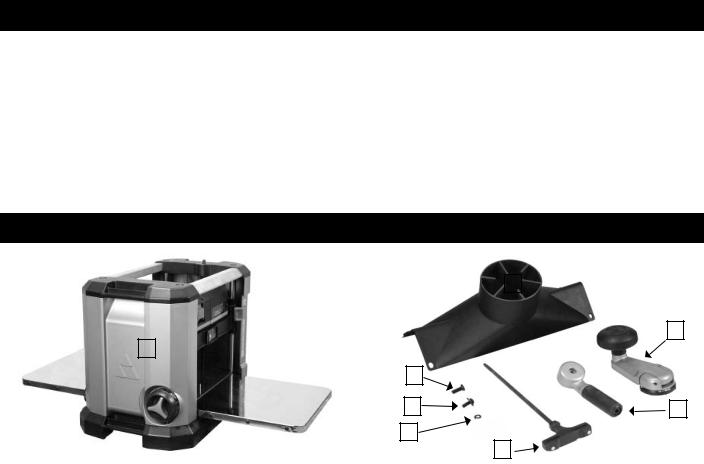
FUNCTIONAL DESCRIPTION
FOREWORD
The DELTA Model 22-590 is a 13" (330 mm) Portable Planer that has a cutting capacity of 13" (330mm) wide, 6" (152mm) thick and 1/8" (3.2 mm) deep. This machine has a powerful 15 amp 120 volt motor with a three-knife cutterhead.
NOTICE: The photo on the manual cover illustrates the current production model. All other illustrations contained in the manual are representative only and may not depict the actual labeling or accessories included. These are intended to illustrate technique only.
CARTON CONTENTS
|
|
|
|
|
|
|
|
|
|
|
|
|
|
|
|
|
|
|
|
|
|
|
|
|
|
|
|
|
|
|
|
|
|
|
|
|
|
2 |
|
|
|
|
|
|
|
|
|
|
|
|
|
|
|
|
|
|
|
|
|
|
|
|
|
|
|
|
|
|
|
|
|
|
|
|
|
|
|
|
|
|
|
|
|
|
|
|
3 |
|
|
||
|
|
|
|
1 |
|
|
|
|
|
|
|
|
|
|
|
|
|
|
|
|
|
|
|
|
|
|
|
|
|
|
|
|
|
|
|
|
|
|
|
|
|
|
|
|
|
|
|
|
|
|
|
|
6 |
|
|
|
|
|
|
|
|
|
|
|
||||
|
|
|
|
|
|
|
|
|
|
|
|
|
|
|
|
|
|
|
|
|
||
|
|
|
|
|
|
|
7 |
|
|
|
|
|
|
|
|
|
|
|
||||
|
|
|
|
|
|
|
|
|
|
|
|
|
4 |
|
|
|||||||
|
|
|
|
|
|
|
|
|
|
|
|
|
|
|
|
|
|
|
|
|
|
|
|
|
|
|
|
|
|
|
|
|
|
|
|
|
|
|
|
|
|
|
|
||
|
|
|
|
|
|
|
8 |
|
|
|
|
|
|
|
|
|
|
|
|
|||
|
|
Fig. 1A |
|
|
|
|
|
|
|
|
|
|
|
|
Fig. 1B |
|
|
|||||
|
|
|
|
|
|
|
|
|
|
|
5 |
|
|
|
|
|||||||
|
|
|
|
|
|
|
|
|
|
|
|
|
|
|||||||||
|
|
|
|
|
|
|
|
|
|
|
|
|
|
|
|
|
||||||
|
|
|
|
|
|
|
|
|
|
|
|
|
|
|
|
|||||||
|
|
|
|
|
|
|
|
|
|
|
|
|
|
|
|
|
|
|
|
|
|
|
1. |
Planer |
6. |
|
|
M6 Star Socket Head Screw |
|
|
|
|
|
||||||||||||
2. |
Dust Collection Attachment |
7. |
|
|
M6 Star Socket Head Screw and Washer |
|||||||||||||||||
3. |
Cutterhead Adjusting Handle |
8. |
|
|
6 mm Washer |
|
|
|
|
|
||||||||||||
4.Cutterhead Lock Handle
5.Cutterhead Wrench and Handle Combination
UNPACKING AND CLEANING
 This machine weighs about 75 pounds. Use a helper to lift or move it.
This machine weighs about 75 pounds. Use a helper to lift or move it.
Carefully unpack the machine and all loose items from the shipping container. Peel protective film from the table surface. Figures 1A and 1B illustrate the planer and all loose items supplied with your machine. Refer to the section of this manual entitled “REPLACING KNIVES” to remove the cutterhead guard. Remove the rust-preventative oil from unpainted surfaces using a soft cloth moistened with mineral spirits, paint thinner or denatured alcohol.
 Do not use highly volatile solvents such as gasoline, naphtha, acetone or lacquer thinner for cleaning your machine.
Do not use highly volatile solvents such as gasoline, naphtha, acetone or lacquer thinner for cleaning your machine.
After cleaning, cover the unpainted surfaces with a good quality household floor paste wax.
 Take care when you clean the cutterhead. The knives in the cutterhead are very sharp. After cleaning the cutterhead, replace the cutterhead guard.
Take care when you clean the cutterhead. The knives in the cutterhead are very sharp. After cleaning the cutterhead, replace the cutterhead guard.
6
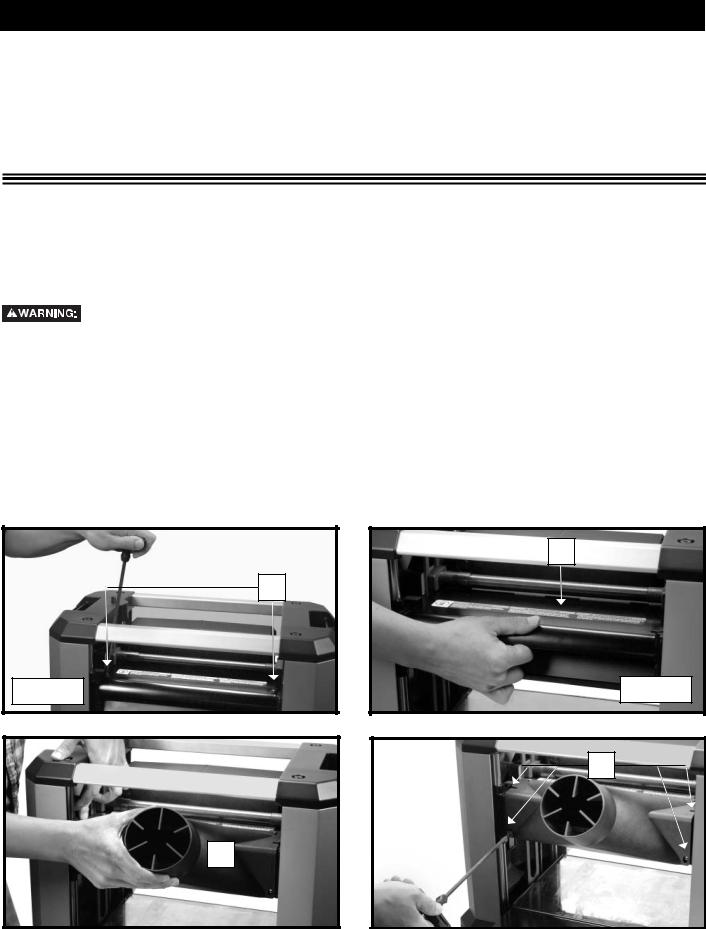
ASSEMBLY
 To reduce the risk of injury, turn unit off and disconnect it from power source before installing and removing accessories, before adjusting or when making repairs. An accidental start-up can cause injury.
To reduce the risk of injury, turn unit off and disconnect it from power source before installing and removing accessories, before adjusting or when making repairs. An accidental start-up can cause injury.
ASSEMBLY TOOLS REQUIRED |
ASSEMBLY TIME ESTIMATE |
Cutterhead Wrench (Supplied) |
Approximately 1/2 hour |
HOW TO PREPARE FOR DUST MANAGEMENT
You have two options for dust management. The first is the dust deflector and the second is the dust collection attachment to attach your machine to a dust collector.
HOW TO INSTALL THE DUST COLLECTION ATTACHMENT
Disconnect the machine from the power source.
1.Remove the two screws (A) Fig. 1C that secure the dust deflector.
2.Remove the dust deflector (B) Fig. 2.
3.Place the dust collection attachment (C) Fig. 3 in the slots provided.
4.Attach the dust collection attachment with the four M6 star socket head screws (D) Fig. 4. Two of these screws were removed in STEP 1. Tighten all fasteners securely.
5.Reverse the procedure for installing the dust deflector. Install the dust deflector with the label up and curved lip pointing down.
 When using the dust collection attachment, do not operate the unit without a hose connected and a dust collector in operation.
When using the dust collection attachment, do not operate the unit without a hose connected and a dust collector in operation.
A |
Fig. 1C |
B
Fig. 2
D
C
Fig. 3 |
|
Fig. 4 |
|
|
|
7
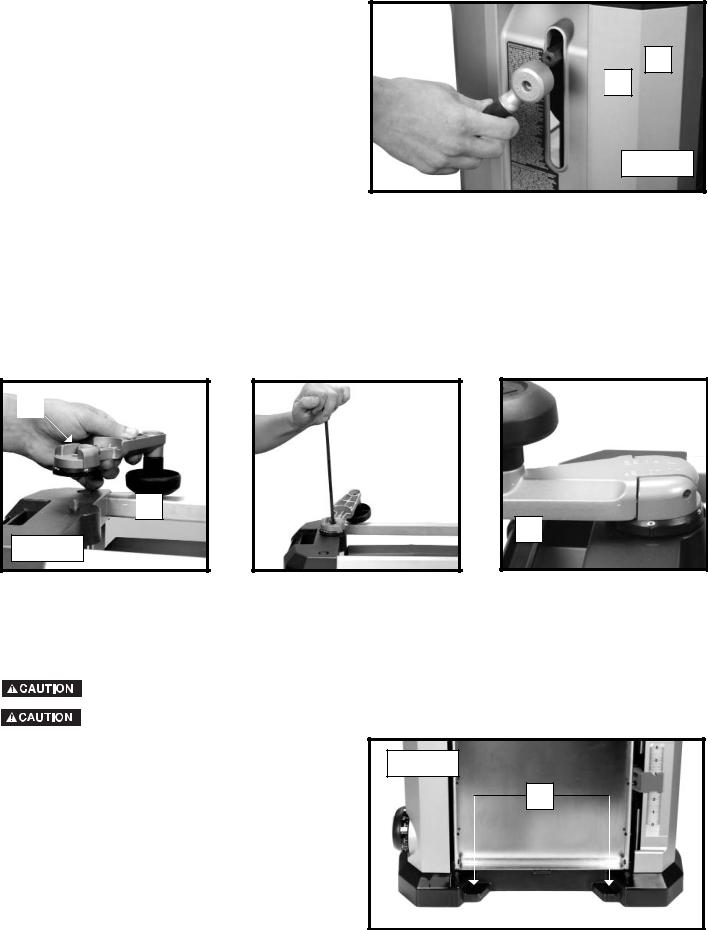
HOW TO ATTACH THE CUTTERHEAD LOCK HANDLE
Use the supplied wrench to attach the cutterhead lock handle (A) Fig. 5 to the shaft (B) with the M6 x 20mm star socket head screw and lockwasher.
 B
B

 A
A
Fig. 5
HOW TO ATTACH THE CUTTERHEAD ADJUSTMENT HANDLE
1.Attach the cutterhead adjustment handle (A) Fig. 6 to the shaft (B), with the flat on the shaft engaged with the flat in the handle.
2.Fasten the cutterhead adjustment handle to the shaft using the M6 x 20mm star socket head screw and lockwasher with the supplied cutterhead wrench (Fig. 7).
NOTE: The cutterhead adjustment handle is supplied with markings (C) Fig. 8 to make your cuts accurate.
A |
|
Fig. 7 |
|
Fig. 8 |
|
|
|
|
|

 B
B
Fig. 6
C 

HOW TO FASTEN THE PLANER TO A SUPPORTING SURFACE


 Before operation, secure the planer to the supporting surface. Four holes (two of which are shown at (A) Fig. 9) are provided for this purpose.
Before operation, secure the planer to the supporting surface. Four holes (two of which are shown at (A) Fig. 9) are provided for this purpose.
Operate the planer on a flat, level surface.
Use ONLY DELTA accessory stands.
Four attachment holes are provided for mounting the planer to a stand or work surface. These holes are located under the infeed and outfeed tables as shown in Fig. 9.
Fig. 9
A
8
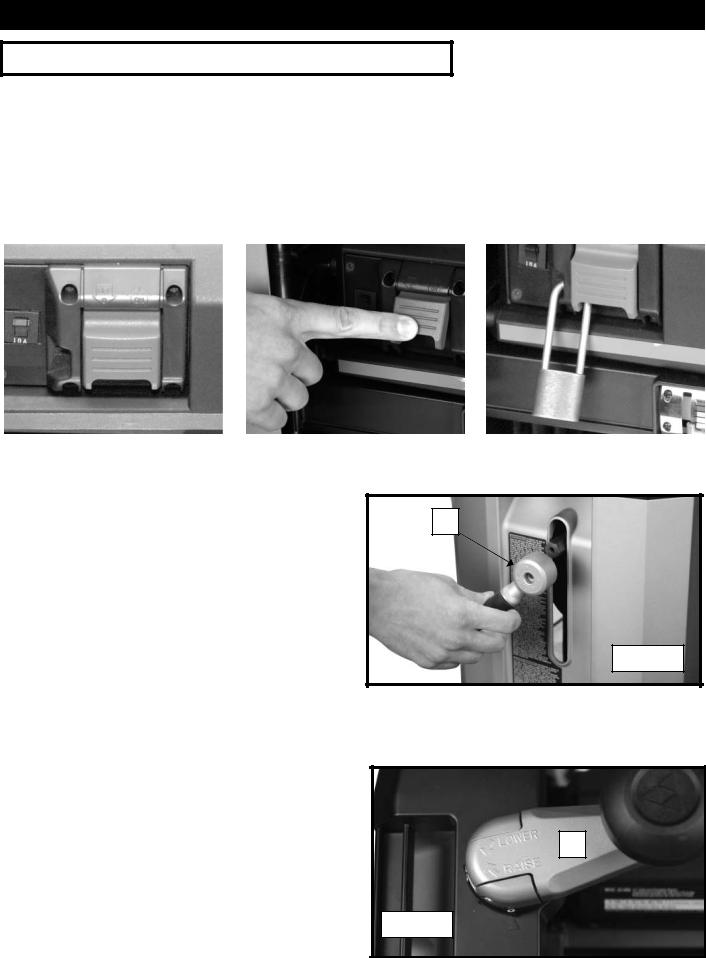
OPERATION
OPERATIONAL CONTROLS AND ADJUSTMENTS
HOW TO START AND STOP THE PLANER
To turn the planer “ON”, lift the paddle (A) Fig. 10. To turn the tool “OFF”, push the paddle down (Fig. 11).
IMPORTANT: When the machine is not in use, the switch should be locked in the “OFF” position to prevent unauthorized use. Place a padlock (B) Fig. 12 with a 1/4" (6.3 mm) diameter shackle through the hole on the left side of the switch cover and through the hole in the switch paddle. Lock the padlock.
 Ensure that the lock prevents the switch from being turned on.
Ensure that the lock prevents the switch from being turned on.
|
|
|
|
|
|
|
|
|
|
|
|
|
|
|
|
|
|
A |
|
|
|
|
|
|
|
|
|
|
|
|
|
|
|
|
|
|
|
|
|
|
|
|
|
|
|
|
|
|
|
|
|
|
|
|
|
|
|
|
|
|
Fig. 10 |
|
|
|
|
|
Fig. 11 |
|
|
|
B |
|
Fig. 12 |
|
|
|
|
|
|
|
|
|
|
|
|
|
|
||
|
|
|
|
|
|
|
|
|
|
|
|
|
|
|
|
|
|
|
|
|
|
|
|
|
|
|
|
|
|
HOW TO USE THE CUTTERHEAD LOCK
The cutterhead lock (A) Fig. 13 helps to eliminate snipe in the board that is being planed. Snipe can also be eliminated by butting boards end to end and feeding them through the planer. Long boards should always be supported, when feeding them through the planer to help eliminate snipe.
A
Fig. 13
HOW TO ADJUST THE HEAD ASSEMBLY
The head assembly contains the cutterhead, feed rollers, chip deflector and motor. Raising and lowering the head assembly controls the depth of cut. To adjust the head assembly, rotate the cutterhead lock handle
(A) Fig. 13 counterclockwise to unlock the cutterhead. Turn the cutterhead adjusting handle clockwise to raise or counter-clockwise to lower the cutterhead. One revolution of handle (A) Fig. 14 will move the cutterhead up or down 1/16" (1.6 mm).
A
Fig. 14
9
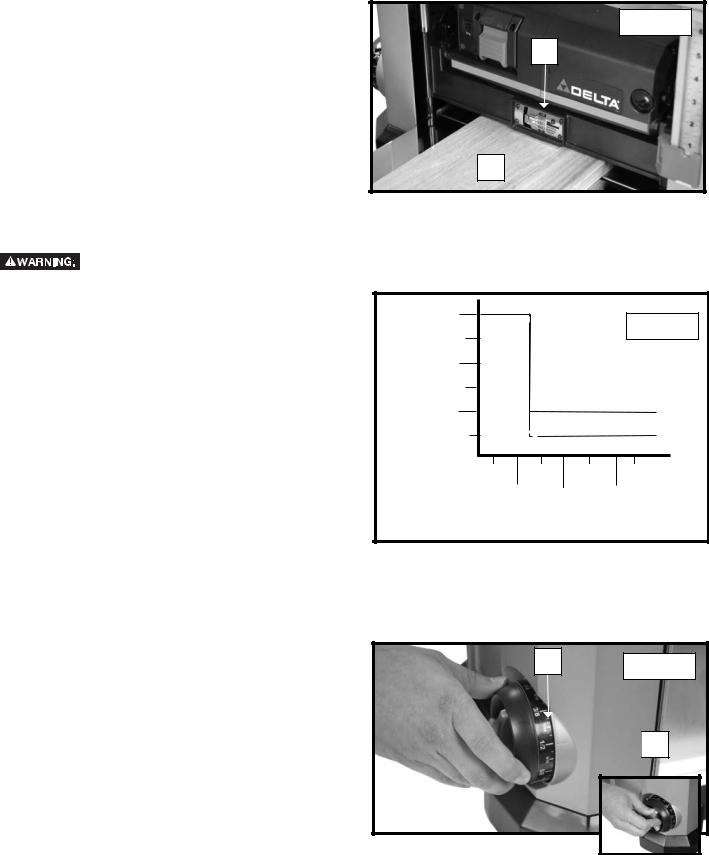
HOW TO USE THE MATERIAL REMOVAL GAUGE
Your planer is equipped with a material removal gauge (A) Fig. 15. It is used to indicate the amount of wood that will be removed in one pass with the carriage set at its current height. The material removal gauge reads across the entire width of the planer head.
1.Slide approximately 3" of the workpiece (B) Fig. 15 under the middle of the carriage.
2.Be sure that the workpiece is lying flat against the base of the planer. If the workpiece is inserted at an angle, the reading may be inaccurate.
3.Lower the carriage on the workpiece until the material removal bar engages the wood. You will see the red arrow moving up the scale to indicate the amount to be removed with the carriage at that height.
4.Adjust the carriage height until the desired depth of cut appears on the gauge.
5.Pull the material out from under the carriage.
6.Turn the unit on and feed your material into the cutter head.
Fig. 15
A
B
NOTE: Do not exceed the recommended depth of cut for various widths of material, shown in the “RECOMMENDED DEPTH OF CUT” section below.
Do not turn the unit “ON” with the workpiece in position.
RECOMMENDED DEPTH OF CUT
NOTE: One revolution of the cutterhead adjusting handle will move the cutterhead up or down 1/16" (1.6 mm).
You can make a 1/8" (3.2 mm) depth-of-cut in soft woods up to 6" (152mm) wide and in hard woods up to 4" (102 mm) wide. (Fig. 16)
For 6" (152 mm) through 13" (330 mm) wide soft wood, use a maximum depth-of-cut of 1/16" (1.6 mm). For 6" (152 mm) through 13" (330 mm) wide hard wood, use a maximum depth-of-cut of 3/64" (1.2 mm) (Fig. 16).
IMPORTANT: A shallow depth-of-cut will produce a better finish.
RECOMMENDED DEPTH OF CUT
1/8" (3.2 mm)
3/32" (2.4 mm)
1/16" (1.6 mm)
Fig. 16
SOFT WOOD
HARD WOOD
2" |
6" |
8" |
10" |
(51 mm) (152 mm) |
(203 mm) (254 mm) |
||
|
4" |
7" |
9" |
(102 mm) (178 mm) |
(229 mm) |
||
WIDTH OF STOCK
HOW TO USE THE DEPTH STOP
Your planer is equipped with a depth stop (A) Fig. 17 for repetitive planing. Any thickness between 1/8" and 1-1/4" can be selected using the scale on the depth stop. Detents are provided at 1/8", 1/4", 1/2", 3/4", 1", and 1-1/4".
To set the minimum depth to which the carriage can travel with the depth stop:
1.Check to see that the carriage is set above 1-1/4" before trying to set the depth stop.
2.Turn the dial on the front left of the planer until the desired thickness setting aligns with the indicator line
(B) Fig. 17.
3.Lock the gauge in place by turning the wheel on the inside of the gauge (Inset – Fig. 17).
4.Plane the workpiece at desired increments until the correct final thickness is achieved.
NOTE: Do not use force to lower the carriage below the level that the depth stop indicates. Permanent damage to the height adjustment system on your planer will result.
A |
Fig. 17 |
|

 B
B
10
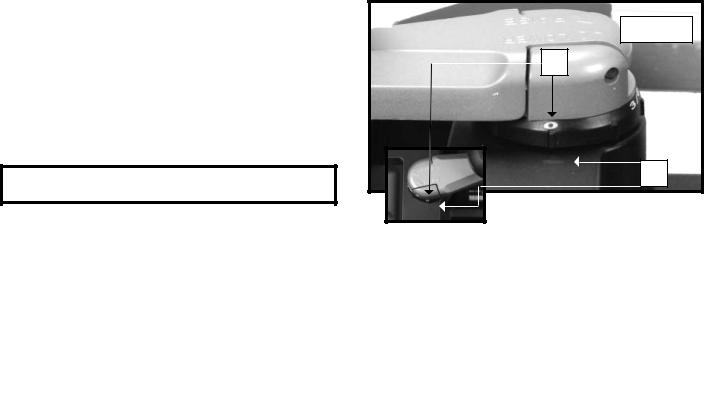
HOW TO USE THE ADJUSTABLE INDEXING RING
The cutterhead adjusting handle has an adjustment ring (A) Fig. 18. To use the adjustment ring to make fine adjustments:
1.Measure the thickness of a planed board.
2.Set the zero position of the ring (A) Fig. 18 to align with the arrow (B).
3.Rotate the handle to the desired depth of cut, as indicated on the ring. Each indicator on the ring is equivalent to 1/128" (.2 mm) for making minute cuts.
4.Plane the workpiece.
MACHINE USE
Follow these few steps to achieve the best results.
Fig. 18 |
A |
B |
1.True One Face – Feed one face of the board over a jointer, making thin cuts with each pass, until the entire surface is flat.
2.Plane to Thickness – Place the side you just surfaced in STEP 1 face down and feed the board through the planer, plane until this side is flat. Then plane both sides of the board until you are satisfied with the thickness, making thin cuts, alternating sides with each pass. If, during the planing operation, you notice the board twisting, warping or bowing, repeat STEP 1 and true one face.
3.When planing long stock, provide additional support to the infeed and outfeed end of the workpiece.
4.Always engage the cutterhead lock before planing. Plane with the grain only, and keep table clean. Occasionally, wax the table surface to reduce friction.
5.Cross-cut the workpiece to its final length.
NOTICE |
Feed the wood through the planer at different places on the table to help eliminate uneven wear of the |
knives.
PROPER PLANING TECHNIQUES
1.Lower the carriage to the desired height for your first pass.
2.Turn the unit on and feed the material into the feed rollers.
3.Examine the finished cut and adjust the carriage to the appropriate height for your next pass.
4.Feed workpieces through alternating areas of the planer for even blade wear – not just through the center of the machine. One way to do this is to start with the workpiece on the left in one pass, in the middle on the next and on the right side for third pass – and then repeat.
NOTE: Flip the board back and forth between each pass.
 Do not turn the unit on with the workpiece inserted under carriage. Wait until the roller and cutterhead are up to full speed before feeding your material into the machine.
Do not turn the unit on with the workpiece inserted under carriage. Wait until the roller and cutterhead are up to full speed before feeding your material into the machine.
For best results, plane both sides of the workpiece to reach desired thickness. For example, if you need to remove 1/8" from your workpiece, remove 1/16" from each side. This not only allows the workpiece to dry with an even moisture content, it also produces finer cuts.
 Plane only wood that is free from foreign objects, with no loose knots and as few tight knots as possible. Do not plane wood that is severely warped, twisted, knotted or bowed.
Plane only wood that is free from foreign objects, with no loose knots and as few tight knots as possible. Do not plane wood that is severely warped, twisted, knotted or bowed.
 Do not place your body between the rear of the planer and a stationary object while material is feeding. Serious injury could result.
Do not place your body between the rear of the planer and a stationary object while material is feeding. Serious injury could result.
MINIMUM/MAXIMUM WIDTH/HEIGHT/DEPTH
NOTE: Always plane in the direction of the grain. Support the workpiece adequately at all times. Planing material less than 3/4" wide is not recommended. If you must plane narrow material, group several pieces together and plane them as one wide workpiece whenever possible. The maximum depth of cut your planer can take in one pass is 1/8" (on material less than 6” wide). Never attempt to modify your planer to take a deeper cut. Follow the recommended depth/width of cut guidelines shown in Fig. 16 for best results.
11
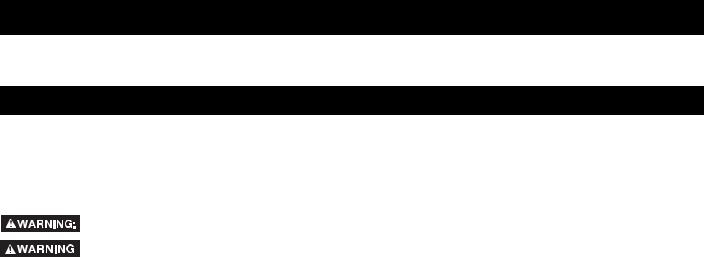
SNIPE
Snipe is a depression made when an unsupported end of your material drops toward the floor, causing the opposite end to lift up into the cutter head.
TO AVOID SNIPE
Feed the workpiece into the planer so it is level and remains flat against the base at all times.
Keep the workpiece level throughout planing operation by receiving or “catching” it from the rear of the planer. If you are planing material that is especially long, the use of additional material support is recommended.
TWISTED, CUPPED AND BOWED WOOD
If both sides of your material are very rough or if the material is cupped, bowed or twisted, your planer may not produce the desired result. Ideally, you should have at least one level face/surface on your material before you plane. Your thickness planer will work best with material that has been run through a jointer to produce one flat surface. If you do not have at least one flat surface or a jointer, see the following recommendations.
TO PLANE TWISTED WOOD
 Twisted wood may jam your planer. If a jam occurs, turn the power “OFF”, disconnect the power supply and raise the carriage to release the workpiece from the cutter.
Twisted wood may jam your planer. If a jam occurs, turn the power “OFF”, disconnect the power supply and raise the carriage to release the workpiece from the cutter.
If your material is only slightly twisted, plane both sides alternating from one to the other until the desired thickness is reached.
TO PLANE CUPPED WOOD
To obtain the best possible results with cupped wood, rip the material down the middle and plane it as two separate pieces. Ripping the material reduces the severity of the cup and allows the machine to deliver better results. Understand that you will have to remove more material on cupped wood to achieve the desired thickness than you would on a normal board. If ripping the material is not an option, plane one side of the material until flat, then plane the opposite side until it is also flat.
NOTE: Do not flip the board back and forth between each pass as recommended by the general planing directions.
TO PLANE BOWED WOOD
The feed rollers and cutter head in your planer will push the bow out of the material as it feeds. However, when the material exits the planer, the pressure of the rollers and cutterhead will release allowing the wood to spring back into a bowed formation. To properly remove the bow, use a jointer.
TROUBLESHOOTING
For assistance with your machine, visit our website at www.deltaportercable.com for a list of service centers or call the DELTA Machinery help line at 1-800-223-7278 (In Canada call 1-800-463-3582).
MAINTENANCE
 To reduce the risk of injury, turn unit off and disconnect it from power source before installing and removing accessories, before adjusting or when making repairs. An accidental start-up can cause injury.
To reduce the risk of injury, turn unit off and disconnect it from power source before installing and removing accessories, before adjusting or when making repairs. An accidental start-up can cause injury.
HOW TO CHECK, ADJUST, CLEAN AND REPLACE KNIVES
 Wear gloves when you remove the knives for sharpening or replacement. The knives in this planer are very sharp.
Wear gloves when you remove the knives for sharpening or replacement. The knives in this planer are very sharp.
Disconnect the machine from the power source.
The knives are sharp. Be careful when removing, handling, or installing knives.
The knives supplied with your planer are double edged and reversible so that you can turn the knives end-for-end when one edge becomes dull or chipped. To change the knives:
1.Raise the head assembly (B) Fig. 19 to 4" (102 mm) on the “Scale and Pointer”.
2.Remove the screws (A) Fig. 19. Pull the chip deflector or dust collection attachment – whichever is installed – (B) straight out.
3.Insert the supplied wrench (C) Fig. 20 into the hex hole. Rotate the cutterhead until the cutterhead lock engages.
4.Remove the seven screws (E) Fig. 21 and use magnetic end of the wrench to remove the hold-down bar (F).
5. Place the magnetized end of the wrench (G) Fig. 22 at the center of the knife. Lift the wrench until the knife
(H) separates from the pins. Remove the knife.
6.Repeat steps 3 through 5 to remove the other two knives. Press down the cutterhead lock release and use the supplied wrench (C) Fig. 20 to rotate the cutterhead lock until the lock engages and the next knife is in position to be removed.
7.IMPORTANT: After removing all knives from cutterhead, carefully set them aside. Using a cloth rag and isopropyl alcohol, clean the cutterhead, knives and hold-down bars free of gum, tar and pitch residue. Take special care to clean the cutterhead under the knife area and the cutterhead radius in front of the knife area. Doing this will increase the life of your planer.
12
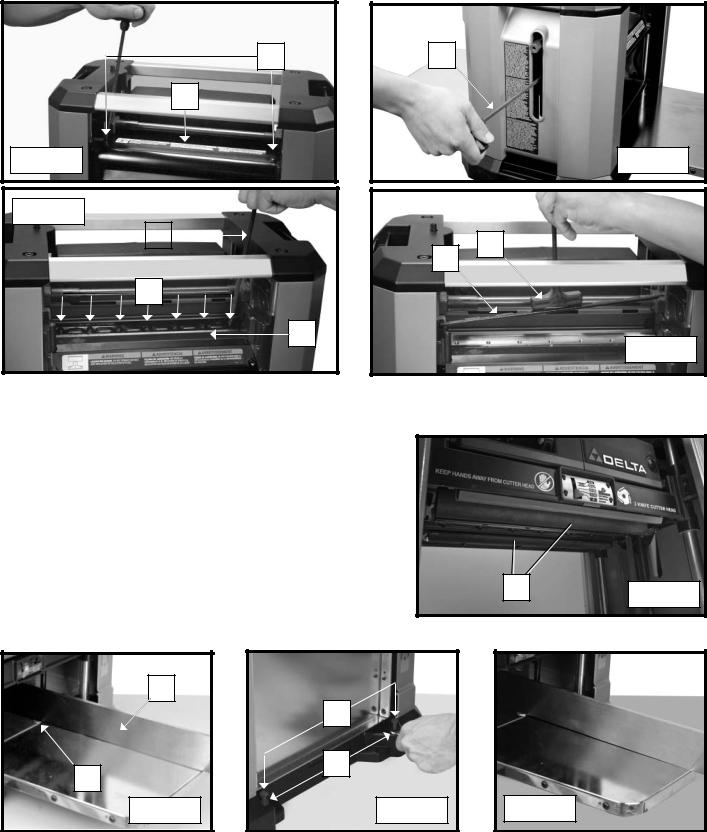
8.Take this time also to clean the rollers (I) Fig. 22A.
9.Your unit is equipped with double-edged knives. If the second edge of the knife has not been used, rotate the knife 180 degrees and replace on the cutterhead. Replace the knives if both sides have been used.
10.Attach the hold-down bar (F) Fig. 21 that you removed in STEP 4. Tighten all fasteners securely.
11.Depress the cutterhead lock release and rotate the cutterhead to the next empty position until the cutterhead lock engages.
12.Repeat steps 9 through 11 to replace the other knives.
13.Reattach the cutterhead guard or dust collection attachment.
A |
B |
Fig. 19 |
C
Fig. 20
Fig. 21
D |
|
G |
|
||
|
|
|
|
|
H |
E
F
Fig. 22
HOW TO ADJUST THE INFEED AND OUTFEED TABLES
Your unit has been factory set to eliminate snipe. If your unit loses its adjustment and causes snipe, you can adjust the infeed and outfeed tables to minimize this condition.
1.Place a dime (A) Fig. 23A at each end of the platen (infeed and outfeed).
2.Place a straight edge (B) across the two dimes. Extend the straight edge past the leading edge of the infeed and trailing edge of the outfeed tables.
3.If your tables are properly adjusted, the straight edge will touch both of the dimes and the edges of the tables (Fig. 23C).
4.If your table needs adjustment, loosen the locknuts (A) Fig. 23B on the table height-adjustment screws (B). Adjust the screws up or down to achieve the desired table height.
5.Make sure that both height-adjustment screws contact the bottom of the table after adjustment.
I |
Fig. 22A |
|
B |
|
|
|
B |
|
A |
A |
|
|
|
|
Fig. 23A |
Fig. 23B |
Fig. 23C |
|
13 |
|
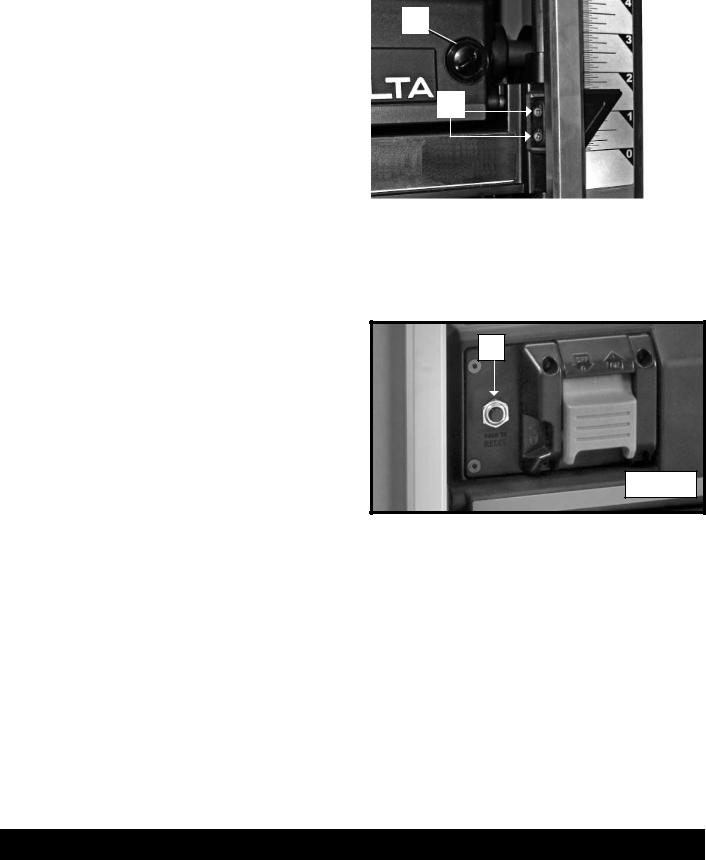
HOW TO CALIBRATE THE DEPTH ADJUSTMENT SCALE |
|
|
|
|
|
|
|
|
|
|
|
|
|
|
|
|
|
|
|
The depth adjustment scale (A) Fig. 23D on your planer is |
|
|
|
|
|
|
|
|
|
set at the factory. However, with extended use, the depth |
|
C |
|
|
|
A |
|
|
|
|
|
|
|
|
|
||||
adjustment scale could show an incorrect measurement. To |
|
|
|
|
|
|
|
|
|
|
|
|
|
|
|
|
|
|
|
check the depth adjustment scale, plane a piece of scrap |
|
|
|
|
|
|
|
|
|
wood, noting the measurement on the depth adjustment |
|
|
|
|
|
|
|
|
|
scale. Measure the finished thickness of the workpiece. If |
|
|
|
|
|
|
|
|
|
the thickness of the workpiece does not match the reading |
|
|
|
B |
|
|
|
|
|
on the depth adjustment scale, loosen the two screws (B) |
|
|
|
|
|||||
|
|
|
|
|
|
|
|
|
|
on the red indicator. Adjust the pointer up or down until its |
|
|
|
|
|
|
|
|
|
reading matches the finished thickness of the workpiece. |
|
|
|
|
|
|
|
|
|
Securely re-tighten the screws. |
|
|
|
|
|
|
|
|
|
BASE MAINTENANCE |
|
|
|
|
|
|
|
Fig. 23D |
|
|
|
|
|
|
|
|
|
|
|
|
|
|
|
|
|
|
|
|
|
Keep the table clean and free from oil, grease, and pitch. |
|
|
|
|
|
|
|
|
|
|
|
|
|
|
|
|
|
|
|
Treat the table with paste wax to help maintain its smooth |
|
|
|
|
|
|
|
|
|
finish. |
|
|
|
|
|
|
|
|
|
CIRCUIT BREAKER RESET BUTTON
Your planer is equipped with an 18 amp circuit breaker. If your planer becomes overloaded and stops operating, turn off the planer, let the unit sit for 2 minutes and press the reset button (A) Fig. 24 before you resume working.
 To prevent the planer from starting unexpectedly if power is interrupted by a circuit
To prevent the planer from starting unexpectedly if power is interrupted by a circuit
breaker trip, make sure the switch is in the "OFF" po- A sition before restoring power.
NOTE: Circuit breaker overload is often the result of dull knives. Change your knives on a regular basis to avoid tripping your breaker. Check your knives before re-set- ting the circuit breaker and continuing to plane.
BRUSH CHANGE
Your planer is equipped with brush caps (C) Fig. 23D that
are external to the motor. If your brushes need to be re- Fig. 24 placed, begin by acquiring a new set from a DELTA Ma-
chinery service center or a dealer authorized to service DELTA products. Use only identical DELTA brushes.
REPLACING THE DRIVE BELT
Drive belts are available at extra cost at DELTA authorized service centers. Replacement of the drive belt should be performed by qualified service personnel.
KEEP MACHINE CLEAN
Periodically blow out all air passages with dry compressed air. All plastic parts should be cleaned with a soft damp cloth. NEVER use solvents to clean plastic parts. They could possibly dissolve or otherwise damage the material.
 Wear certified safety equipment for eye, hearing and respiratory protection while using compressed air.
Wear certified safety equipment for eye, hearing and respiratory protection while using compressed air.
FAILURE TO START
Should your machine fail to start, check to make sure the prongs on the cord plug are making good contact in the outlet. Also, check for blown fuses or open circuit breakers in the line.
LUBRICATION
Apply household floor paste wax to the machine table, extension table or other work surface weekly. Or use a commercially available protective product designed for this purpose. Follow the manufacturer’s instructions for use and safety.
SERVICE
REPLACEMENT PARTS
Use only identical replacement parts. For a parts list or to order parts, visit our website at www.deltaportercableservicenet.com. You can also order parts from your nearest factory-owned branch, or by calling our Customer Care Center at 1-800-223-7278 to receive personalized support from highly-trained technicians.
14
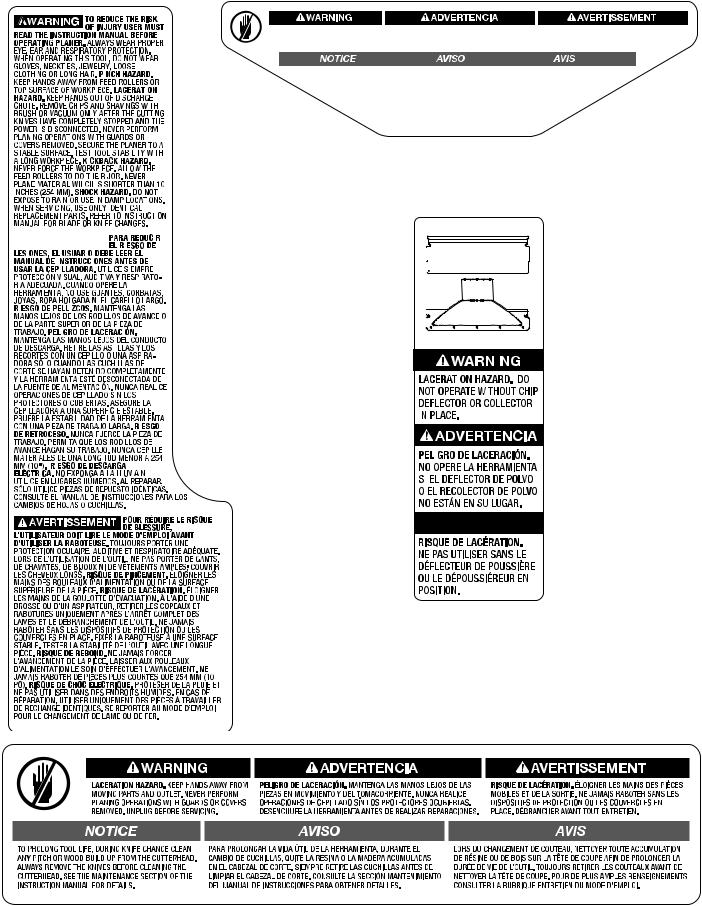
FREE WARNING LABEL REPLACEMENT
If your warning labels become illegible or are missing, call 1-800-223-7278 for a free replacement.
LACERATION HAZARD. KEEP HANDS AWAY FROM MOVING PARTS AND OUTLET. NEVER PERFORM PLANING OPERATIONS WITH GUARDS OR COVERS REMOVED. UNPLUG BEFORE SERVICING.
PELIGRO DE LACERACIÓN. MANTENGA LAS MANOS LEJOS DE LAS PIEZAS EN MOVIMIENTO Y DEL TOMACORRIENTE. NUNCA REALICE OPERACIONES DE CEPILLADO SIN LOS PROTECTORES OCUBIERTAS. DESENCHUFE LA HERRAMIENTA ANTES DE REALIZAR REPARACIONES.
RISQUE DE LACÉRATION. ÉLOIGNER LES MAINS DES PIÈCES MOBILES ET DE LA SORTIE. NE JAMAIS RABOTER SANS LES DISPOSITIFS
DE PROTECTION OU LES COUVERCLES EN PLACE. DÉBRANCHER AVANT TOUT ENTRETIEN.
|
|
|
|
|
|
|
|
|
|
|
|
|
|
|
|
|
|
|
|
|
|
|
|
|
|
TO PROLONG TOOL LIFE, DURING KNIFE CHANGE |
|
PARA PROLONGAR LA VIDA ÚTIL DE LA |
|
|
|
||||||||
|
|
|
|
|
|
|
|
|
|
|
|
|
|
|
|
|
|
|
|
|
|
|
|
|
|
|
|
|
|
||||||||||
|
|
|
|
|
|
|
|
|
|
|
|
|
|
|
|
|
|
|
|
|
|
|
|
|
|
|
|
|
|
||||||||||
|
|
|
|
|
|
|
|
|
|
|
|
|
|
|
|
|
|
|
|
|
|
|
|
|
|
|
|
|
|
||||||||||
|
|
|
|
|
|
|
|
|
|
|
|
|
|
|
|
|
|
|
|
|
|
|
|
|
|
CLEAN ANY PITCH OR WOOD BUILD UP FROM |
|
HERRAMIENTA, DURANTE EL CAMBIO DE |
|
|
|
||||||||
|
|
|
|
|
|
|
|
|
|
|
|
|
|
|
|
|
|
|
|
||||||||||||||||||||
|
|
|
|
|
|
|
|
|
|
|
|
|
|
|
|
|
|
|
|
|
|
|
|
|
|
THE CUTTERHEAD. ALWAYS REMOVE THE |
|
CUCHILLAS, QUITE LA RESINA O LA MADERA |
|
|
|
||||||||
|
|
|
|
|
|
|
|
|
|
|
|
|
|
|
|
|
|
|
|
|
|
|
|
|
|
KNIVES BEFORE CLEANING THE |
|
ACUMULADAS EN EL CABEZAL DE CORTE. |
|
|
|
||||||||
|
|
|
|
|
|
|
|
|
|
|
|
|
|
|
|
|
|
|
|
|
|
|
|
|
|
CUTTERHEAD. SEE THE |
|
SIEMPRE RETIRE LAS CUCHILLAS ANTES DE |
|
|
|
||||||||
|
|
|
|
|
|
|
|
|
|
|
|
|
|
|
|
|
|
|
|
|
|
|
|
|
|
MAINTENANCE SECTION |
|
LIMPIAR EL CABEZAL DE CORTE. CONSULTE |
|
|
|
||||||||
|
|
|
|
|
|
|
|
|
|
|
|
|
|
|
|
|
|
|
|
|
|
|
|
|
|
OF THE INSTRUCTION |
|
LA SECCIÓN MANTENIMIENTO DEL MANUAL |
|
|
|
||||||||
|
|
|
|
|
|
|
|
|
|
|
|
|
|
|
|
|
|
|
|
|
|
|
|
|
|
|
|
||||||||||||
|
|
|
|
|
|
|
|
|
|
|
|
|
|
|
|
|
|
|
|
|
|
|
|
|
|
MANUAL FOR |
|
DE INSTRUCCIONES PARA OBTENER |
|
|
|
||||||||
|
|
|
|
|
|
|
|
|
|
|
|
|
|
|
|
|
|
|
|
|
|
|
|
|
|
DETAILS. |
|
DETALLES. |
|
|
|
||||||||
|
|
|
|
|
|
|
|
|
|
|
|
|
|
|
|
|
|
|
|
|
|
|
|
|
|
|
|
|
|
|
|
|
|
|
|
|
|
|
|
|
|
|
|
|
|
|
|
|
|
|
|
|
|
|
|
|
|
|
|
|
|
|
|
|
|
|
|
|
|
|
|
|
|
|
|
|
|
|
|
|
|
|
|
|
|
|
|
|
|
|
|
|
|
|
|
|
|
|
|
|
|
|
|
|
|
|
|
|
|
|
|
|
|
|
|
|
|
|
|
|
|
|
|
|
|
|
|
|
|
|
|
|
|
|
|
|
|
|
|
|
|
|
|
|
|
|
|
|
|
|
|
|
|
|
|
|
|
|
|
|
|
|
|
|
|
|
|
|
|
|
|
|
|
|
|
|
|
|
|
|
|
|
|
|
|
|
|
|
|
|
|
|
|
|
|
|
|
|
|
|
|
|
|
|
|
|
|
|
|
|
|
|
|
|
|
|
|
|
|
|
|
|
|
|
|
|
|
|
|
|
|
|
|
|
|
|
|
|
|
|
|
|
|
|
|
|
|
|
|
|
|
|
|
|
|
|
|
|
|
|
|
|
|
|
|
|
|
|
|
|
|
|
|
|
|
|
|
|
|
|
|
|
|
|
|
|
|
|
|
|
|
|
|
|
|
|
|
|
|
|
|
|
|
|
|
|
|
|
|
|
|
|
|
|
|
|
|
|
|
|
|
|
|
|
|
|
|
|
|
|
|
|
|
|
|
|
|
|
|
|
|
|
|
|
|
|
|
|
|
|
|
|
|
|
|
|
|
|
|
|
|
|
|
|
|
|
|
|
|
|
|
|
|
|
|
|
|
|
|
|
|
|
|
|
|
|
|
|
|
|
|
|
|
|
|
|
|
|
|
|
|
|
|
|
|
|
|
|
|
|
|
|
|
|
|
|
|
|
|
|
|
|
|
|
|
|
|
|
|
|
|
|
|
|
|
|
|
|
|
|
|
|
|
|
|
|
|
|
|
|
|
|
|
|
|
|
|
|
|
|
|
|
|
|
|
|
|
|
|
|
|
|
|
|
|
|
|
|
|
|
|
|
|
|
|
|
|
|
|
|
|
|
|
|
|
|
|
|
|
|
|
|
|
|
|
|
|
|
|
|
|
|
|
|
|
|
|
|
|
|
|
|
|
|
|
|
|
|
|
|
|
|
|
|
|
|
|
|
|
|
|
|
|
|
|
|
|
|
|
|
|
|
|
|
|
|
|
|
|
|
|
|
|
|
|
|
|
|
|
|
|
|
|
|
|
|
|
|
|
|
|
|
|
|
|
|
|
|
|
|
|
|
|
|
|
|
|
|
|
|
|
|
|
|
|
|
|
|
|
|
|
|
|
|
|
|
|
|
|
|
|
|
|
|
|
|
|
|
|
|
|
|
|
|
|
|
|
|
|
|
|
|
|
|
|
|
|
|
|
|
|
|
|
|
|
|
|
|
|
|
|
|
|
|
|
|
|
|
|
|
|
|
|
|
|
|
|
|
|
|
|
|
|
|
|
|
|
|
|
|
|
|
|
|
|
|
|
|
|
|
|
|
|
|
|
|
|
|
|
|
|
|
|
|
|
|
|
|
|
|
|
|
|
|
|
|
|
|
|
|
|
|
|
|
|
|
|
|
|
|
|
|
|
|
|
|
|
|
|
|
|
|
|
|
|
|
|
|
|
|
|
|
|
|
|
|
|
|
|
|
|
|
|
|
|
|
|
|
|
|
|
|
|
|
|
|
|
|
|
|
|
|
|
|
|
|
|
|
|
|
|
|
|
|
|
|
|
|
|
|
|
|
|
|
|
|
|
|
|
|
|
|
|
|
|
|
|
|
|
|
|
|
|
|
|
|
|
|
|
|
|
|
|
|
|
|
|
|
|
|
|
|
|
|
|
|
|
|
|
|
|
|
|
|
|
|
|
|
|
|
|
|
|
|
|
|
|
|
|
|
|
|
|
|
|
|
|
|
|
|
|
|
|
|
|
|
|
|
|
|
|
|
|
|
|
|
|
|
|
|
|
|
|
|
|
|
|
|
|
|
|
|
|
|
|
|
|
|
|
|
|
|
|
|
|
|
|
|
|
|
|
|
|
|
|
|
|
|
|
|
|
|
|
|
|
|
|
|
|
|
|
|
|
|
|
|
|
|
|
|
|
|
|
|
|
|
|
|
|
|
|
|
|
|
|
|
|
|
|
|
|
|
|
|
|
|
|
|
|
|
|
|
|
|
|
|
|
|
|
|
|
|
|
|
|
|
|
|
|
|
|
|
|
|
|
|
|
|
|
|
|
|
|
|
|
|
|
|
|
|
|
|
|
|
|
|
|
|
|
|
|
|
|
|
|
|
|
|
|
|
|
|
|
|
|
|
|
|
|
|
|
|
|
|
|
|
|
|
|
|
|
|
|
|
|
|
|
|
|
|
|
|
|
|
|
|
|
|
|
|
|
|
|
|
|
|
|
|
|
|
|
|
|
|
|
|
|
|
|
|
|
|
|
|
|
|
|
|
|
|
|
|
|
|
|
|
|
|
|
|
|
|
|
|
|
|
|
|
|
|
|
|
|
|
|
|
|
|
|
|
|
|
|
|
|
|
|
|
|
|
|
|
|
|
|
|
|
|
|
|
|
|
|
|
|
|
|
|
|
|
|
|
|
|
|
|
|
|
|
|
|
|
|
|
|
|
|
|
|
|
|
|
|
|
|
|
|
|
|
|
|
|
|
|
|
|
|
|
|
|
|
|
|
|
|
|
|
|
|
|
|
|
|
|
|
|
|
|
|
|
|
|
|
|
|
|
|
|
|
|
|
|
|
|
|
|
|
|
|
|
|
|
|
|
|
|
|
|
|
|
|
|
|
|
|
|
|
|
|
|
|
|
|
|
|
|
|
|
|
|
|
|
|
|
|
|
|
|
|
|
|
|
|
|
|
|
|
|
|
|
|
|
|
|
|
|
|
|
|
|
|
|
|
|
|
|
|
|
|
|
|
|
|
|
|
|
|
|
|
|
|
|
|
|
|
|
|
|
|
|
|
|
|
|
|
|
|
|
|
|
|
|
|
|
|
|
|
|
|
|
|
|
|
|
|
|
|
|
|
|
|
|
|
|
|
|
|
|
|
|
|
|
|
|
|
|
|
|
|
|
|
|
|
|
|
|
|
|
|
|
|
|
|
|
|
|
|
|
|
|
|
|
|
|
|
|
|
|
|
|
|
|
|
|
|
|
|
|
|
|
|
|
|
|
|
|
|
|
|
|
|
|
|
|
|
|
|
|
|
|
|
|
|
|
|
|
|
|
|
|
|
|
|
|
|
|
|
|
|
|
|
|
|
|
|
|
|
|
|
|
|
|
|
|
|
|
|
|
|
|
|
|
|
|
|
|
|
|
|
|
|
|
|
|
|
|
|
|
|
|
|
|
|
|
|
|
|
|
|
|
|
|
|
|
|
|
|
|
|
|
|
|
|
|
|
|
|
|
|
|
|
|
|
|
|
|
|
|
|
|
|
|
|
|
|
|
|
|
|
|
|
|
|
|
|
|
|
|
|
|
|
|
|
|
|
|
|
|
|
|
|
|
|
|
|
|
|
|
|
|
|
|
|
|
|
|
|
|
|
|
|
|
|
|
|
|
|
|
|
|
|
|
|
|
|
|
|
|
|
|
|
|
|
|
|
|
|
|
|
|
|
|
|
|
|
|
|
|
|
|
|
|
|
|
|
|
|
|
|
|
|
|
|
|
|
|
|
|
|
|
|
|
|
|
|
|
|
|
|
|
|
|
|
|
|
|
|
|
|
|
|
|
|
|
|
|
|
|
|
|
|
|
|
|
|
|
|
|
|
|
|
|
|
|
|
|
|
|
|
|
|
|
|
|
|
|
|
|
|
|
|
|
|
|
|
|
|
|
|
|
|
|
|
|
|
|
|
|
|
|
|
|
|
|
|
|
|
|
|
|
|
|
|
|
|
|
|
|
|
|
|
|
|
|
|
|
|
|
|
|
|
|
|
|
|
|
|
|
|
|
|
|
|
|
|
|
|
|
|
|
|
|
|
|
|
|
|
|
|
|
|
|
|
|
|
|
|
|
|
|
|
|
|
|
|
|
|
|
|
|
|
|
|
|
|
|
|
|
|
|
|
|
|
|
|
|
|
|
|
|
|
|
|
|
|
|
|
|
|
|
|
|
|
|
|
|
|
|
|
|
|
|
|
|
|
|
|
|
|
|
|
|
|
|
|
|
|
|
|
|
|
|
|
|
|
|
|
|
|
|
|
|
|
|
|
|
|
|
|
|
|
|
|
|
|
|
|
|
|
|
|
|
|
|
|
|
|
|
|
|
|
|
|
|
|
|
|
|
|
|
|
|
|
|
|
|
|
|
|
|
|
|
|
|
|
|
|
|
|
|
|
|
|
|
|
|
|
|
|
|
|
|
|
|
|
|
|
|
|
|
|
|
|
|
|
|
|
|
|
|
|
|
|
|
|
|
|
|
|
|
|
|
|
|
|
|
|
|
|
|
|
|
|
|
|
|
|
|
|
|
|
|
|
|
|
|
|
|
|
|
|
|
|
|
|
|
|
|
|
|
|
|
|
|
|
|
|
|
|
|
|
|
|
|
|
|
|
|
|
|
|
|
|
|
|
|
|
|
|
|
|
|
|
|
|
|
|
|
|
|
|
|
|
|
|
|
|
|
|
|
|
|
|
|
|
|
|
|
|
|
|
|
|
|
|
|
|
|
|
|
|
|
|
|
|
|
|
|
|
|
|
|
|
|
|
|
|
|
|
|
|
|
|
|
|
|
|
|
|
|
|
|
|
|
|
|
|
|
|
|
|
|
|
|
|
|
|
|
|
|
|
|
|
|
|
|
|
|
|
|
|
|
|
|
|
|
|
|
|
|
|
|
|
|
|
|
|
|
|
|
|
|
|
|
|
|
|
|
|
|
|
|
|
|
|
|
|
|
|
|
|
|
|
|
|
|
|
|
|
|
|
|
|
|
|
|
|
|
|
|
|
|
|
|
|
|
|
|
|
|
|
|
|
|
|
|
|
|
|
|
|
|
|
|
|
|
|
|
|
|
|
|
|
|
|
|
|
|
|
|
|
|
|
|
|
|
|
|
|
|
|
|
|
|
|
|
|
|
|
|
|
|
|
|
|
|
|
|
|
|
|
|
|
|
|
|
|
|
|
|
|
|
|
|
|
|
|
|
|
|
|
|
|
|
|
|
|
|
|
|
|
|
|
|
|
|
|
|
|
|
|
|
|
|
|
|
|
|
|
|
|
|
|
|
|
|
|
|
|
|
|
|
|
|
|
|
|
|
|
|
|
|
|
|
|
|
|
|
|
|
|
|
|
|
|
|
|
|
|
|
|
|
|
|
|
|
|
|
|
|
|
|
|
|
|
|
|
|
|
|
|
|
|
|
|
|
|
|
|
|
|
|
|
|
|
|
|
|
|
|
|
|
|
|
|
|
|
|
|
|
|
|
|
|
|
|
|
|
|
|
|
|
|
|
|
|
|
|
|
|
|
|
|
|
|
|
|
|
|
|
|
|
|
|
|
|
|
|
|
|
|
|
|
|
|
|
|
|
|
|
|
|
|
|
|
|
|
|
|
|
|
|
|
|
|
|
|
|
|
|
|
|
|
|
|
|
|
|
|
|
|
|
|
|
|
|
|
|
|
|
|
|
|
|
|
|
|
|
|
|
|
|
|
|
|
|
|
|
|
|
|
|
|
|
|
|
|
|
|
|
|
|
|
|
|
|
|
|
|
|
|
|
|
|
|
|
|
|
|
|
|
|
|
|
|
|
|
|
|
|
|
|
|
|
|
|
|
|
|
|
|
|
|
|
|
|
|
|
|
|
|
|
|
|
|
|
|
|
|
|
|
|
|
|
|
|
|
|
|
|
|
|
|
|
|
|
|
|
|
|
|
|
|
|
|
|
|
|
|
|
|
|
|
|
|
|
|
|
|
|
|
|
|
|
|
|
|
|
|
|
|
|
|
|
|
|
|
|
|
|
|
|
|
|
|
|
|
|
|
|
|
|
|
|
|
|
|
|
|
|
|
|
|
|
|
|
|
|
|
|
|
|
|
|
|
|
|
|
|
|
|
|
|
|
|
|
|
|
|
|
|
|
|
|
|
|
|
|
|
|
|
|
|
|
|
|
|
|
|
|
|
|
|
|
|
|
|
|
|
|
|
|
|
|
|
|
|
|
|
|
|
|
|
|
|
|
|
|
|
|
|
|
|
|
|
|
|
|
|
LORS DU CHANGEMENT DE COUTEAU, NETTOYER TOUTE ACCUMULATION DE RÉSINE OU DE BOIS SUR LA TÊTE DE COUPE AFIN DE PROLONGER LA DURÉE DE VIE DE L’OUTIL. TOUJOURS RETIRER LES COUTEAUX
AVANT DE NETTOYER LA TÊTE DE COUPE. POUR DE PLUS AMPLES RENSEIGNEMENTS, CONSULTER
LA RUBRIQUE ENTRETIEN DU MODE D’EMPLOI.
 AVERTISSMENT
AVERTISSMENT
15
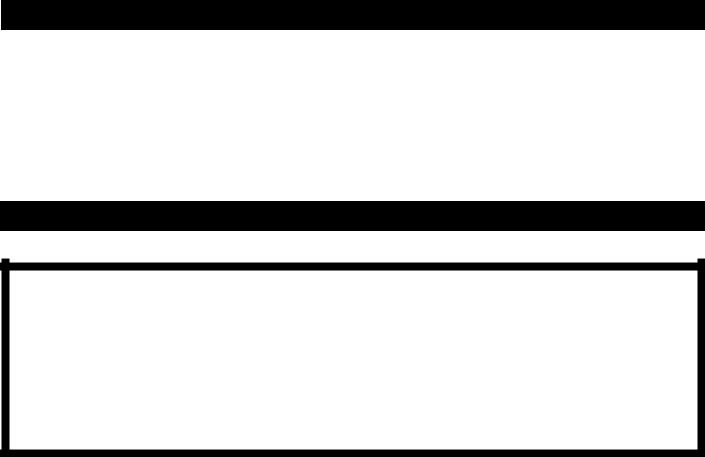
SERVICE AND REPAIRS
All quality tools will eventually require servicing and/or replacement of parts. For information about DELTA Machinery, its factory-owned branches, or an Authorized Warranty Service Center, visit our website at www.deltaportercable.com or call our Customer Care Center at 1-800-223-7278. All repairs made by our service centers are fully guaranteed against defective material and workmanship. We cannot guarantee repairs made or attempted by others.
You can also write to us for information at DELTA Machinery, 4825 Highway 45 North, Jackson, Tennessee 38305 - Attention: Product Service. Be sure to include all of the information shown on the nameplate of your tool (model number, type, serial number, etc.)
ACCESSORIES
 Since accessories other than those offered by DELTA have not been tested with this product, use of such accessories could be hazardous. For safest operation, only DELTA recommended accessories should be used with this product.
Since accessories other than those offered by DELTA have not been tested with this product, use of such accessories could be hazardous. For safest operation, only DELTA recommended accessories should be used with this product.
A complete line of accessories is available from your DELTA Supplier, Porter-Cable•DELTA Factory Service Centers, and DELTA Authorized Service Stations. Please visit our Web site www.deltaportercable.com for a catalog or for the name of your nearest supplier.
WARRANTY
To register your tool for warranty service visit our website at www.deltaportercable.com.
Five Year Limited New Product Warranty
DELTA will repair or replace, at its expense and at its option, any new DELTA machine, machine part, or machine accessory which in normal use has proven to be defective in workmanship or material, provided that the customer returns the product prepaid to a DELTA factory service center or authorized service station with proof of purchase of the product within five years and provides DELTA with reasonable opportunity to verify the alleged defect by inspection. For all refurbished DELTA product, the warranty period is 180 days. DELTA will not be responsible for any asserted defect which has resulted from normal wear, misuse, abuse or repair or alteration made or specifically authorized by anyone other than an authorized DELTA service facility or representative. Under no circumstances will DELTA be liable for incidental or consequential damages resulting from defective products. Some states do not allow the exclusion or limitation of incidental or consequential damages, so the above limitation or exclusion may not apply to you. This warranty is DELTA’s sole warranty and sets forth the customer’s exclusive remedy, with respect to defective products; all other warranties, express or implied, whether of merchantability, fitness for purpose, or otherwise, are expressly disclaimed by DELTA. For further detail of warranty coverage and warranty repair information, visit www.deltaportercable.com or call (888) 848-5175. This warranty gives you specific legal rights and you may have other rights which vary in certain states or provinces.
LATIN AMERICA: This warranty does not apply to products sold in Latin America. For products sold in Latin America, see country specific warranty information contained in the packaging, call the local company or see website for warranty information.
16
